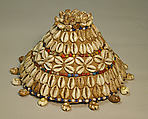Prestige Cap (Laket mishiing)
Not on view
This richly ornamented cap (laket) was worn as a sign of the elite status of its owner. The form is composed of a piece of woven raffia palm fabric that was cut and shaped into a wide cone. Cowrie shells and white, blue, yellow, black, and red glass beads are stitched onto its surface. The beads are sewn to the raffia fabric in four horizontal bands running along the base, center, and crown. Cowries fill the interstices in alternating registers of double parallel lines and x-forms. Sixteen evenly spaced cowries jut out at a slight diagonal from the lower perimeter, tightly held in place by raffia fiber threads. A mass of cowries are stitched to stand on end at the summit, forming a blossom-like shape. Such prestige caps were secured at the crown of the head by a long metal pin stuck horizontally through the cap and hair. That attachment can be seen in a laket mishiing (laket cap with string decoration) in the Met’s collection (1974.83.19a, b)
Established as a confederacy of chiefdoms by the seventeenth century, Kuba society is organized into eighteen distinct subgroups, each of which has an internal political hierarchy. One’s elite status within the hierarchy was underscored by such headgear. Classified generally as laket, small raffia caps signified both personal and cultural identity and function as the primary means of communicating one’s status within the local political hierarchy. While primarily worn by titleholding men, conical or scalloped-edged laket were also worn by some female dignitaries. Laket are given to their owners at a variety of stages in life: they are first received upon the completion of initiation as a sign of one’s adult status and readiness for marriage. Later, more elaborate models are gifted to individuals along with titles and praise names as a sign of their personal achievement. Cowrie-covered examples belonged to individuals of the highest ranking titles in a given village. As the shells and glass beads were imported, they were a costly luxury commodity in scarce supply. This laket was produced by a Bushoong artist, a member of an elite Kuba subgroup known for its elaborate royal regalia and textiles. Men were not only the primary patrons of prestige caps, but also their authors. At the time this hat was created, weaving raffia palm fiber was a male vocation among the Kuba.
Kristen Windmuller-Luna, 2016
Sylvan C. Coleman and Pam Coleman Memorial Fund Fellow in the Department of the Arts of Africa, Oceania, and the Americas
Further Reading
Binkley, David Aaron., and Patricia Darish. Kuba. Milan: 5 Continents, 2009.
Cornet, Joseph. Art Royal Kuba. Milano: Edizioni Sipiel, 1982.
Vansina, Jan. Le Royaume Kuba. Tervuren, Belgium: Musée Royal De L'Afrique Centrale, 1964.
Due to rights restrictions, this image cannot be enlarged, viewed at full screen, or downloaded.

